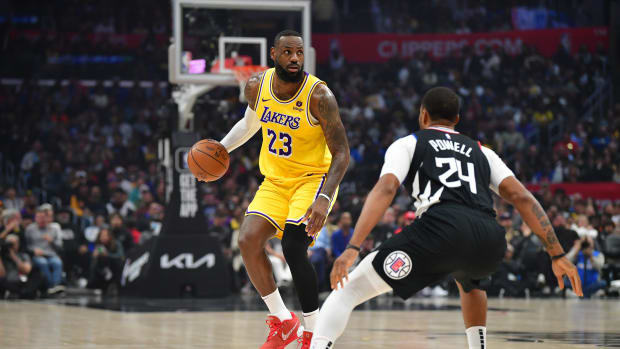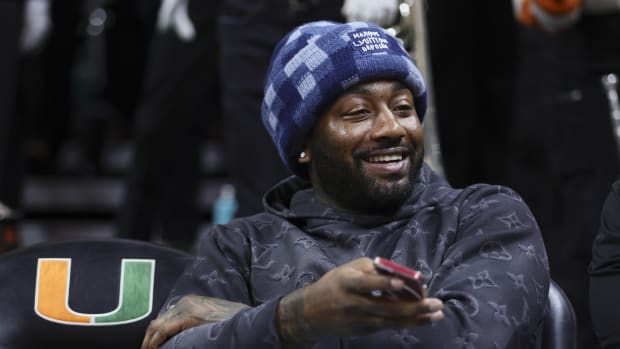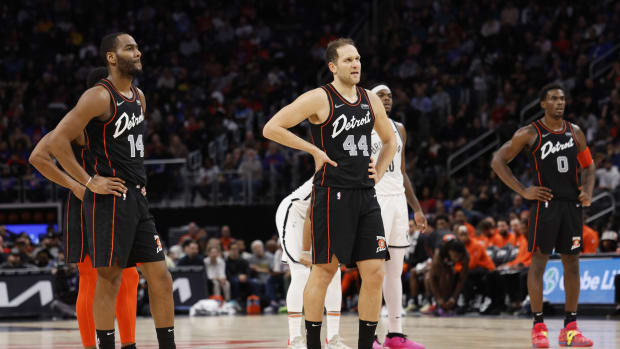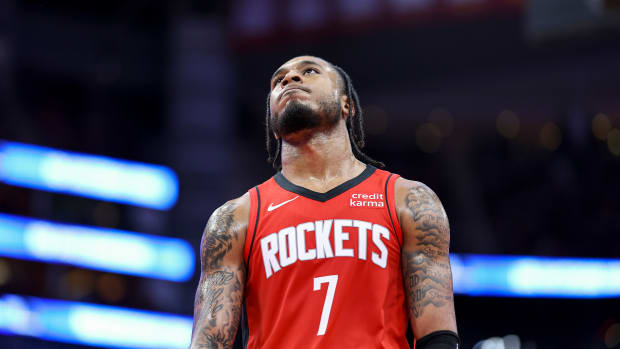NBA, NBPA Agreement Doesn't Preclude Future Labor Issues if Coronavirus Drags On
The NBA and the National Basketball Players’ Association have reached an agreement that will ensure labor peace for the time being. However, the agreement doesn’t foreclose the possibility of the league invoking the force majeure clause in Article XXXIX of the collective bargaining agreement.
As reported by ESPN’s Adrian Wojnarowski, the two sides have negotiated a near-term pay arrangement that addresses the league’s continuing shutdown on account of the coronavirus disease pandemic. The arrangement instructs that players, who are generally paid twice per month, will be paid in full on May 1. However, beginning on May 15, 25% of each player’s salary will held in escrow. The agreement also contemplates additional—and gradual—pay reductions should the league invoke the force majeure clause and cancel all or some of the remainder of the 2019-20 season.
Writing for Variety, Sportico’s Scott Soshnick adds that the withholding agreement ensures that players “would spread any lost salary over time instead of having checks stop immediately. Most players are compensated on a 12-month basis.” He also notes these funds will remain in escrow until there is clarity on whether all or some of the postponed games will be re-scheduled.
The withholding agreement ensures the NBA and NBPA will continue to work collaboratively for at least the near future and perhaps well beyond. The league clearly intends to resume the 2019-20 season if at all possible. Resumption of play could include playing all games in one arena without spectators. In that setting, players, coaches, staff and referees would be regularly tested and quarantined.
In remarks to media on Friday, commissioner Adam Silver noted the league has “a strong recognition that there are thousands of jobs impacted by the NBA, not just the players and the basketball staff ... I think it’s why the league sees it as our obligation to the extent we can resume play in a safe way to look at every potential way of doing so."
While more than 36,000 Americans and more than 1,000 Canadians have died of COVID-19, there is cautious optimism that the number of new cases appears to be flattening in certain parts of the U.S. and Canada. Also, there is encouraging, albeit preliminary, data regarding the efficacy of the antiviral medicine remdesivir in treating severe COVID-19 symptoms. There’s no doubt the pandemic will continue for weeks and probably months. However, it’s possible that certain kinds of normal activity will gradually come back and boost the sagging economy. Whether NBA games played in the U.S. and/or Canada would be part of that activity remains to be seen.
LISTEN: Open Floor Podcast Previews ESPN's Michael Jordan Documentary
It’s worth noting that most of the 2019-20 NBA season is complete. Teams have played their five exhibition games along with between 64 and 67 of their 82 regular season games. For lottery-bound teams, between 79% and 83% of the NBA season is over. The completion percentage isn’t quite as high for playoff-bound teams, but even they have played most of the league season. Particularly if playoff series were shortened, the NBA might need not a long stretch of time to finish a season that began last fall. Also, some states—particularly Florida—seem determined to entice sports leagues to play their games there. Maybe a return can really happen.
That’s the optimistic take. A more cautious view would reflect that the pandemic seems likely to remain problematic for many months and cause outbreaks in different places at different times. Along those lines, a vaccine might not be available for another couple of years. During that time, better testing and more effective medicines and treatments might emerge, but there would be no guarantees. We are truly living in uncertain times.
Also, even if all NBA games could be played in one arena without running afoul of any state or local gathering restrictions, shelter-in-place orders and non-essential services closings, the logistics of regularly testing players, coaches, staff and referees—not to mention housing them, perhaps without allowing them access to their spouses and children—seem daunting. There are still other possible complications, including whether a player who suffers an injury would be able to receive treatment at a nearby hospital, whether a team could add a player to its roster when that player wasn’t under quarantine and whether everything would shut down again if infections occurred.
If this more pessimistic projection captures how the future plays out, the NBA would likely cancel the 2019-20 season. At that time, the league would be poised to invoke the collectively bargained force majeure clause.
Understanding the mechanics of force majeure
As outlined in Article XXXIX of the CBA, the force majeure clause permits the NBA to terminate the CBA and reduce teams’ obligations to pay players for games that are canceled on account of a qualifying cataclysmic event. One such event is an epidemic, a condition that has clearly been met.
The NBA has 60 days from the beginning of a cataclysmic event to notify the union that it will declare force majeure. The start date of the relevant event—the COVID-19 pandemic—isn’t automatically clear. However, a sensible start date would be either March 11, when the league suspended the 2019-20 season, or March 13, when President Donald Trump proclaimed a national emergency. In either case, and absent other agreement by the league and the players’ association, the NBA would have until the second week of May to inform the NBPA that it intends to invoke the clause.
Force majeure would cause players’ pay to be reduced by 1/92.6th for each lost game. The 92.6th denominator is derived from teams playing five exhibition games, 82 regular season games and, on average, 5.6 playoff games. This structure would lead to players losing about one-fifth of their pay for the season should all remaining games be lost.
The NBA invoking force majeure—thereby terminating the CBA—could eventually spark a labor battle
Terminating the CBA is not a move that the NBA would take lightly. It could spur collateral damage in its mostly positive relationship with the players’ association. It could also potentially open the door to antitrust litigation.
The NBA and NBPA were aware of those risks when they negotiated the CBA, which contains anti-conflict measures. To that end, Article XXXIX obligates both sides to engage in good faith negotiations for a 60-pay period following the league informing the NBPA of invoking the clause. Those negotiations would concern bargaining a new CBA. Players would be barred from striking during that time and the league would be prohibited from locking the players out.
Even if the 60 days pass without an agreement on a new CBA, the terms of the expired CBA would continue in effect. Under federal labor law those terms continue to govern so long as the NBA and NBPA remain in good faith bargaining. The worry would be if after some period of time, perhaps by the fall or winter, the two sides come to an intractable impasse. In that scenario, NBA players could vote to decertify the NBPA and then use federal litigation to challenge the legality of league rules that enable competing teams to refrain from economic competition.
The NBA draft, the rookie wage scale, the salary cap and maximum player salaries are all policies that antitrust law would find problematic. Each involves competing businesses—the teams—joining hands to restrain the manner in which teams compete.
Take the NBA draft. It permits one team to exclusively claim the NBA employment rights of an amateur player and deny him a chance to negotiate with different and preferred NBA teams, some of whom might be willing to pay him more money if there was no rookie wage scale. The draft, of course, helps to ensure that the best new talent is distributed to the weakest NBA teams. That, in turn, should eventually make the weakest teams competitive. That may sound logical, but most industries don’t behave that way. The valedictorian at MIT or Caltech isn’t obligated to join the worst engineering firm in the U.S. He or she can go to the best firm and be paid accordingly. The NBA, like other leagues, is different from the engineering industry. It is a joint venture of teams and its success hinges on all teams having a legitimate shot to win.
That exercise might seem a little academic, but it’s exactly the kind of discussion that would occur in an antitrust lawsuit where the focus would be on whether a particular restraint of trade promotes or harms economic competition. No such viable lawsuit can occur so long as the NBA’s rules are contained in a CBA. Under federal labor law, collectively bargained rules impacting employees’ hours, wages and other working conditions are generally exempt from antitrust lawsuits. For a defendant, the best defense in a case is that the area of law pleaded by the plaintiff simply doesn’t apply. That is particularly true with antitrust litigation, which is very expensive and complex. This is not currently a concern for the NBA since there is a CBA in effect. But as discussed above, that could potentially change.
At a minimum, antitrust litigation would prove disruptive to the league. It’s happened before, most recently in the aftermath of the 2011 NBA lockout. Both sides are working to prevent it from happening again, but nothing is certain in the world they—and us—now occupy.
We’ll keep you posted on key developments.
Michael McCann is SI’s Legal Analyst. He is also an attorney and the Director of the Sports and Entertainment Law Institute at the University of New Hampshire Franklin Pierce School of Law.


































